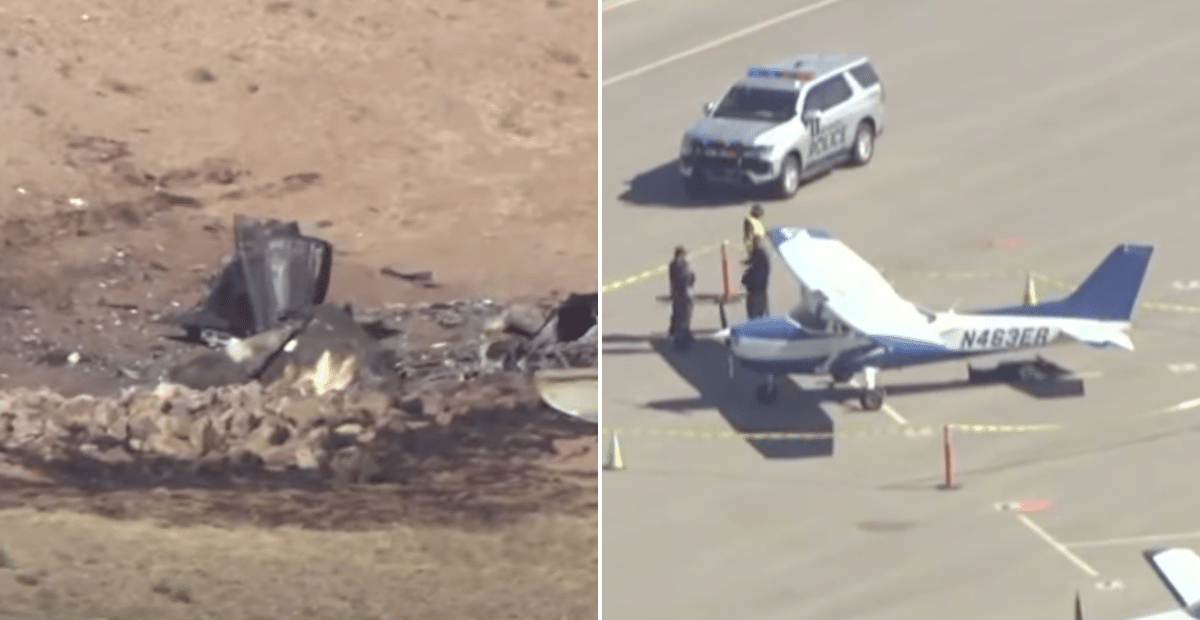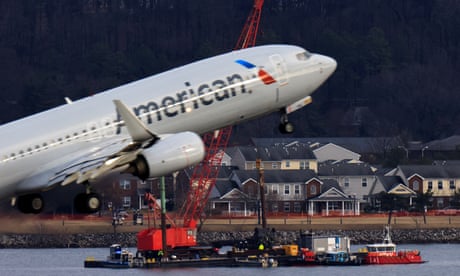Opinion
Arizona Plane Crash Kills Two—Is the U.S. Aviation Sector Struggling? Why Are So Many Planes Crashing?
Published
2 days agoon

Another day, another aviation disaster. This time, tragedy struck in southern Arizona, where two small planes collided midair near Marana Regional Airport, just outside Tucson. Sadly, both people aboard each aircraft lost their lives.
According to federal air-safety investigators, one of the planes managed to land safely, but the other crashed near a runway and burst into flames. It’s yet another dark reminder that the skies over the U.S. haven’t been as safe as we’d like to believe lately.
A String of Crashes—What’s Going On?
Aviation accidents seem to be happening at an alarming frequency. In just the past few weeks, we’ve seen multiple crashes raising serious concerns about air safety in the U.S. –
Feb. 17: Delta plane crash in Toronto
A regional CRJ-900 jet crashed while landing and flipped upside down at Toronto Pearson International Airport about 2:45 p.m. Eastern time. The Delta Air Lines flight operated by regional subsidiary Endeavor Air was flying from Minneapolis.
All 80 passengers were evacuated and survived, according to the Federal Aviation Administration.
The Transportation Safety Board of Canada is investigating. Early reports suggest windy and snowy conditions may have played a role in the crash.
Feb. 10: Scottsdale Airport plane crash
A Learjet 35A crashed into a parked Gulfstream 200 jet about 2:45 p.m. Arizona time after landing at Scottsdale Airport. An initial statement from the FAA said the Learjet “veered off the runway after landing.”
Four people were aboard the Learjet and one was aboard the Gulfstream at the time of the crash, according to the FAA. The pilot of the Learjet, 78-year-old Joie Vitosky, died.
The Learjet is owned by Vince Neil, lead singer of the heavy metal band Mötley Crüe. A statement from a representative of Neil said he was not aboard the plane at the time of the crash.
The FAA and the National Transportation Safety Board are investigating. Early reports suggest the Learjet’s landing gear failed during landing; the reason for the failure will likely be part of the investigation.
Feb. 6: Cessna Crash
A small Cessna 208B Grand Caravan carrying ten people vanished while flying from Unalakleet to Nome, Alaska. The FAA sent out a search-and-rescue alert, but by the time authorities found the wreckage, it was too late—all ten people on board had perished.
According to the U.S. Coast Guard, radar data showed a sudden and drastic drop in altitude and speed before the crash. What caused it? That’s still under investigation. But this is just one in a string of devastating air disasters that have left passengers and industry experts deeply concerned.
Jan. 31: Philadelphia Plane Crash
A Learjet 55 air ambulance carrying six Mexican nationals crashed just minutes after takeoff from Northeast Philadelphia Airport. Tragically, all six onboard and one person on the ground lost their lives. The impact damaged nearby homes, injured 20 people, and left investigators scrambling for answers.
Jan. 29: Washington, D.C., Midair Collision
A PSA Airlines CRJ-700 regional jet operating an American Airlines flight collided with an Army Black Hawk helicopter while approaching the runway at Ronald Reagan Washington National Airport. All 67 people on board both aircraft were killed. Early investigations suggest radio communication failures and altitude miscalculations might have played a role.
And that’s just scratching the surface. From small private planes to commercial jets, accidents are piling up.

Is the U.S. Aviation Sector Struggling?
The sheer number of crashes is alarming, and it’s no surprise that aviation groups are now demanding emergency action.
On Wednesday, major players in the industry—including Airlines for America, the Aerospace Industries Association, and the International Air Transport Association—urged Congress to step up and fix the growing cracks in the system.
In a joint letter, they highlighted some shocking realities:
🔹 The FAA is short by 3,500 air traffic controllers, forcing overworked staff into mandatory overtime and six-day workweeks.
🔹 Outdated technology—some air traffic control systems are over 50 years old, with broken heating, leaking roofs, and radar systems that desperately need replacement.
🔹 Biden had proposed $8 billion to modernize aging aviation infrastructure, but is it enough?
So, Should We Be Worried?
Aviation experts will tell you that flying is still the safest way to travel—and statistically, that’s true. But what about the factors leading to these recent crashes? Understaffed control towers, outdated equipment, increasing air traffic—it all adds up.
With airlines, unions, and industry leaders ringing alarm bells, the real question is—will the government step up before another tragedy unfolds?
Because at this rate, passengers aren’t just worried. They’re scared.
But lets go down another rabbit hole!
The Rabbit Hole
Aviation disasters aren’t exactly new, but the frequency and patterns of recent crashes raise some unsettling questions. Could it be just a coincidence? A tragic series of unrelated mechanical failures, human errors, and poor regulations all converging at once? Or—let’s get conspiratorial—is something bigger at play?
1) Sabotage? Cyber Warfare? A Coordinated Attack?
In today’s world, cyberattacks can cripple entire infrastructures. We’ve seen it in financial systems, power grids, and even government agencies. Could U.S. aviation be the next big target?
A 2023 pilot alert system outage led to the first nationwide U.S. ground stop since 2001. That wasn’t just a glitch—it disrupted 11,000 flights.
The FAA’s tech is so outdated, they can’t even get spare parts for many systems. Imagine how easy it would be for a hacker to exploit that.
What if these crashes weren’t accidents but a test run for something larger?
Now, I’m not saying a foreign actor is behind this, but if they wanted to weaken U.S. confidence and economy, attacking its aviation system would be a surefire way to do it.
2) Are We Witnessing a Cover-Up?
Let’s talk about the Washington, D.C., midair collision—a major airline jet collides with an Army Black Hawk? Above the nation’s capital? That’s beyond rare, and it just so happens that key radio transmissions didn’t reach the helicopter crew?
Did someone deliberately interfere with radio signals?
3) Deregulation, Corporate Greed & Neglect
If we step away from the spy-thriller angle, there’s a more mundane—but equally sinister—possibility, corporate and government negligence is catching up to us.
Airlines have been cutting costs at the expense of safety. Planes are being pushed to their limits, maintenance schedules are being stretched, and profits come first. The FAA is underfunded and understaffed. Controllers are burnt out, overworked, and making life-or-death decisions on little sleep and high stress.
4. The Unthinkable. Are These “Accidents” a Way to Push Privatization?
Here’s a dark theory, what if these repeated failures are being allowed to happen as a way to push for a privatized air traffic control system?
The aviation lobby groups explicitly stated that they do not support privatization. But when systems keep failing, and crashes keep happening, public trust in the FAA crumbles.
What’s the easiest way to get Congress to sell off air traffic control? Show that the government can’t handle it anymore.
Thus, could this be an elaborate ploy by corporate interests waiting to swoop in and take over U.S. air traffic control for profit?

The Last Bit
From Arizona crash to Washington’s midair collision, we may never get clear answers. Aviation experts will tell you that flying is still the safest way to travel—and statistically, that’s true. But what about the factors leading to these recent crashes? Understaffed control towers, outdated equipment, increasing air traffic—it all adds up.
With airlines, unions, and industry leaders ringing alarm bells—will the Trump government step up before another tragedy unfolds?

You may like
-


The American Airlines Crash, Is Trump Trumpeting A Wrong Narrative—From California Wildfires To The Aviation Disaster, Is Blaming DEI For Everything Justified?
-


American Airlines Jet Collides With Army Hawk And Crashes Into Potomac River. A Tragic Echo Of The 1982 Air Florida Flight 90 Disaster – How Did This Happen?